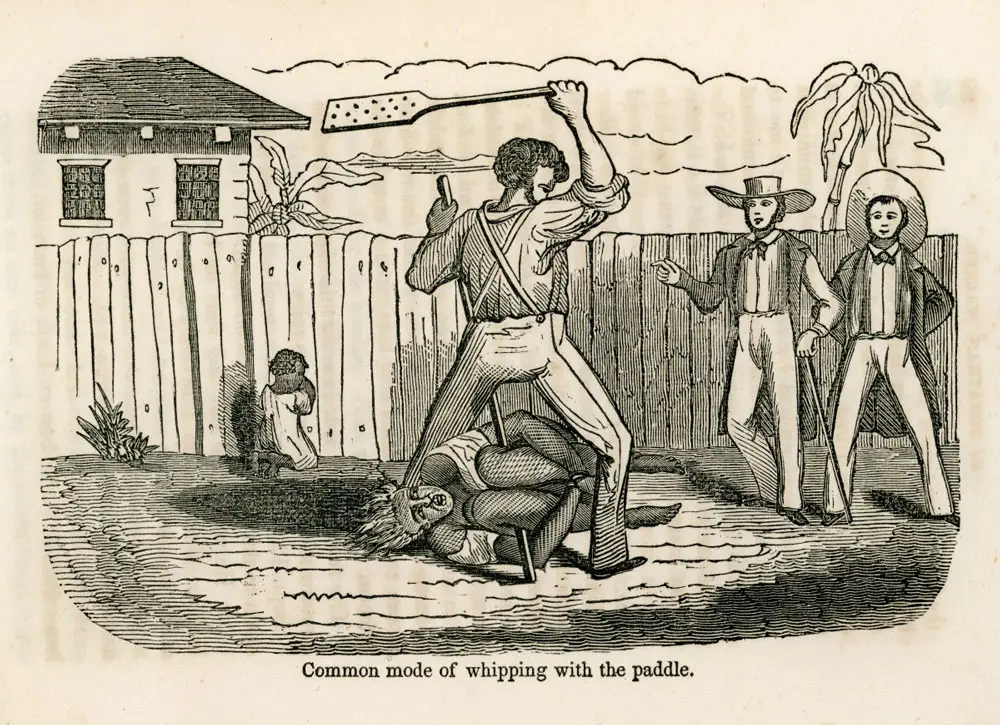
By Raphael E. Rogers
Nervous. Concerned. Worried. Wary. Unprepared.
This is how middle and high school teachers have told me they have felt over the past few years when it comes to teaching the troublesome topic of slavery.
Although I work with teachers in Massachusetts, their reaction to teaching about slavery is common among teachers throughout the U.S.
Fortunately, in recent years there have been a growing number of individuals who have weighed in with useful advice.
Some, such as history professors Hasan Kwame Jeffries and Kenneth Greenberg, have advocated for helping students see the ways in which enslaved people fought back against the brutality of slavery. Whether through a focus on the fight to maintain family and culture, resistance at work, running away, physical confrontation or revolt, students get a deeper understanding of slavery when the lessons include the various ways that enslaved people courageously fought against their bondage.
Others, like James W. Loewen, the author of the popular book “Lies My Teacher Told Me,” have argued for a focus on how slavery has deeply influenced our popular culture through movies, television series, historical fiction and music.
There are also those who recommend the use of specific resources and curriculum materials, like the Harriet Jacobs Papers Project, the four-part documentary series “Africans in America” and the Freedom on the Move database, which features thousands of runaway slave advertisements.
Heeding some of these recommendations, in my work with teachers we have sought to come up with lessons that students like Ailany Rivas, a junior at Claremont Academy in Worcester, Massachusetts, say have helped them to become “more informed and educated about the brutal history of slavery and its legacy.” These lessons that I have developed take a variety of approaches but are all rooted in taking a look at the realities of slavery using historical evidence.
![]() Many students have echoed Ailany in feedback that I have collected from nine different classes where I have helped design lessons about slavery.
Many students have echoed Ailany in feedback that I have collected from nine different classes where I have helped design lessons about slavery.
And the teachers whom I have worked with have all shared informally that they are now confident in taking on the challenge of teaching the complex history of slavery.
Much of this confidence, in my opinion, is due to four things that I believe are mandatory for any teacher who plans to deal with slavery.
1. Explore actual records
Few things shine the light on the harsh realities of slavery like historical documents. I’m talking about things such as plantation records, slave diaries and letters penned by plantation owners and their mistresses.
It also pays to examine wanted advertisements for runaway slaves. These ads provided details about those who managed to escape slavery. In some cases, the ads contain drawings of slaves.
These materials can help teachers guide students to better understand the historical context in which slavery existed. Educators may also wish to look at how people such as historian Cynthia Lynn Lyerly, who wrote a chapter in “Understanding and Teaching American Slavery,” have used historical documents to teach about slavery.
2. Examine historical arguments
In order to better understand different perspectives on slavery, it pays to examine historical arguments about how slavery developed, expanded and ended.
Students can read texts that were written by abolitionists like Frederick Douglass and pro-slavery advocates like George Fitzhugh.
They should wade through the newspaper advertisements that provided details about those who managed to escape slavery.
Looking at these different arguments will show students that history is filled with disagreement, debate and interpretations based on different goals.
For instance, in examining arguments about slavery, teachers can show students how early 20th-century historians like Ulrich Bonnell Phillips
sought to put forth ideas about kind masters and contented slaves, while others from the 1990s, such as John Hope Franklin, co-author of “Runaway Slaves: Rebels on the Plantation,” focused on how Black people resisted slavery.
Seeing these starkly different portrayals of slavery gives students a chance to examine how things such as choice, context, racism and bias might affect the way slavery is seen or viewed.
3. Highlight lived experiences
In my 11 years of teaching history, many students entered my classes with a great deal of misinformation about what life was like for those who lived under slavery. In pre-unit surveys, some stated that the enslaved worked only in the cotton fields and were not treated that badly. We know the historical records tell a different story. While many worked as field hands, there were others who were put into service as blacksmiths, carpenters, gunsmiths, maids and tailors.
To combat misconceptions like this, I advise teachers to use historical sources that feature details about the lived experiences of enslaved people.
For instance, teachers should have students read Harriet Jacobs’ memoir – “Incidents in the Life of a Slave Girl” – alongside diaries written by white plantation owners.
Scrutinize photographs of slave quarters and excerpts from the Born in Slavery: Slave Narratives from the Federal Writers’ Project, which contains more than 2,300 first-person accounts of slavery.
Ask students to examine various historical sources to gain a better understanding of how people lived through their bondage over time.
4. Consider the relevance
It is also crucial for teachers to consider the various ways in which slavery is relevant to the present with their students. I advise them to ask questions like: How has the history of slavery influenced the status of Black people in the United States today? Why are there so many movies about slavery?
In Ailany’s class, we ended our unit by providing students with a chance to read and think about the relevance of recent picture books about slavery like Patricia Polacco’s “January’s Sparrow,” Ann Turner and James Ransome’s “My Name Is Truth: The Life of Sojourner Truth” and Frye Gallard, Marti Rosner and Jordana Haggard’s “The Slave Who Went to Congress.”
We asked students to draw on what they had learned about slavery to consider and then share their perspectives about the historical accuracy, classroom appropriateness and relevance of a selected picture book. Students always have much to say about all three.
Teaching slavery has been and will continue to be challenging. To teachers who are asked or required to take on this challenge, the four things discussed above can serve as strong guideposts for creating lessons that should make the challenge easier to navigate.
![]()
![]() Raphael E. Rogers is Associate Professor of Practice at Clark University in Massachusetts. This article is republished from The Conversation under a Creative Commons license. Read the original article.
Raphael E. Rogers is Associate Professor of Practice at Clark University in Massachusetts. This article is republished from The Conversation under a Creative Commons license. Read the original article.




























History Buff says
The first thing that should be taught about slavery in America is how it came about. Both Europeans and Africans were complicit in the slave trade. All too often the issue of slavery is taught to children as if Europeans pulled up on boats to the coast of Africa and just started rounding people up and loading them onto boats. In reality the slave trade could never have flourished without Africans that captured people through tribal warfare or raiding rival tribes and enslaving the populations. They would then take their captives to the coast where they would be traded for items such as iron objects and firearms. The two European nations who got the slave trade rolling were the English and the Portuguese. Slavery was and is an absolutely horrible and unfortunate part of the history of people across the globe. It has gone on for thousands of years and unfortunately will probably continue to go on while there is profit to be made in the exploitation of others.
Dennis says
I ever owned a slave, you were never a slave. It’s a very dark time in American history. Review the wrongs but move on. Don’t teach kids to haste each other because of what someone else did. It’s like hating Germans, Japanese, and Mexicans because of past wars. Time to move on and stop the hate.
Mike Cocchiola says
Typical conservative response. “I wasn’t there so why should I pay for it? Let’s just move on.” But the effects of our deplorable past still exist – in our schools, politics, housing, law enforcement, economy, and in peoples’ minds. Until we come to terms with that and make proper reparations to the descendants of slaves and those still ravaged by Jim Crow laws we cannot have social equality and social harmony.
WrongTake👆🏻 says
Those who forget the past are doomed to repeat it. Teaching the wrongs of the world is necessary. Moving on and forgetting them doesn’t negate they happened. It’s not about teaching hate. It’s about teaching the wrongs and how to right them.
I wasn’t a slave owner but then again, I’m a proud Yankee, whose ancestors, on my father’s side, and my mother’s father’s side fought for the North in the Civil War. My mother’s mother’s family was Jewish, and still in Hungary/Austria at this time. They eventually had to flee because of persecution. They first arrived here in 1920. My great grandmother gave birth to my grandmother not long before they left.
During WW2, my maternal grandparents built hideouts in our basement to hide themselves and my newborn mother (1940) from the Nazi, if they ever came here. The town I grew up in had a siren to warn them if the Germans were coming. It was primarily a Jewish town. I had an older mother, she was 40 when she had me, which was old in 1980. I’m her only child. I’m also 2nd generation American, on her side.
My life was full of hate, people calling me Jew Girl, making the Nazi hand salute. As a kid, I didn’t understand why they did that. I was raised in my father’s religion, Lutheran. We never spoke of the Jewish side of my history. Apparently, to them my name and my “look” said to them I was Jewish. My mother eventually told me that yes, her maternal side is Jewish. She said she erased all of that to prevent me from knowing the hate she experienced. She said people hate because they are uneducated. So, with her help, we educated them.
We went to my school and told them I wasn’t the only Jew in my class and they needed to do something. They did. They listened. They educated and people changed. It didn’t happen overnight and not everyone came around but many did, and many apologized. This is why teaching history, true history is so important. Facts are necessary to assuage preconceived ideas, rumors, hateful misplaced thoughts, and unify. But that’s the problem isn’t it? A unified populace, has the power that can fight against a tyrannical government.
So to your point, no one alive has been a slave or a slave owner, and shouldn’t we do all we can to make sure it never happens again? Racism is alive. It never disappeared. The history of slavery, the persecution of Native Americans, anti-semitism, prejudice against Muslims, hate against LGBTQ people, it’s there, it’ll always be there. But if education can change one mind, it may be that mind that makes a true difference in helping all groups come together and realize, we are all just people. We really are the same.
Ray W. says
Thank you so much, WrongTake, for your account of your own experiences and those of your family.
Kat says
Thank you for sharing that very personal story, it gives context to the discussion.
Lin says
History Buff and Dennis
Yes, slavery has existed for thousands of years among different ethnic groups and through many wars and continents. I would love to have seen some context here. It is not just an American issue.
Also, I would like to have seen some stories about how slavery was defeated here in the USA.
It is important to study slavery but leaving out context only serves to divide us further.
Local says
Not all slaves we African either. Teach that also.slavery still is happening today. Teach that. Slavery has been around since the beginning of human history. Teach that.
I was never enslaved and don’t know anyone who was. Teach the basics and move on.
Sherry says
We need to do MUCH MORE than simply “review the wrongs” and move on!
We need to deeply understand that the “systemic, entrenched racism” that was born of treating other human beings as “beasts of burden” is still being played out in our American society and culture each and every day! We need each civilized person to step up and do all in their power to STOP the horrific bigotry and discrimination that “should” NOT be any part of who we are as Americans.
Lin says
You call it red herrings, I call it history. Your edit is different from mine but I do not deny yours. Denying mine promotes what we are trying to overcome.
Sherry says
Stating again and again that slavery did not begin in the United States, and that it has existed for thousands of years does “NOT”, “NOT” make it OK to simply acknowledge it and “move on”. Anymore than saying that “murder’ and “rape” happens all the time. . . so what?
How pathetic that there still exists a segment of our populace that is so devoted to a cult, or has been radicalized to a point that they have chosen to stop evolving as individual, thoughtful, caring human beings.
The path to peaceful, equitable, global co-existence between humans is NOT found in ignorance, hate, fear and division. Each of us can do our parts daily by striving to create an EQUAL, better life for “ALL” by bravely “learning the lessons” of ACCURATE historical FACTS, and acknowledging the terrible ripple effects of those atrocities. Acknowledgement is just the beginning.
While our government leaders and policing entities must step up and light the way, moving away from the systemic racism/bigotry/prejudice in our country needs to be the responsibility of each and every person living here. A piece of legislation will not create EQUALITY, it is our minds and hearts that need to evolve.